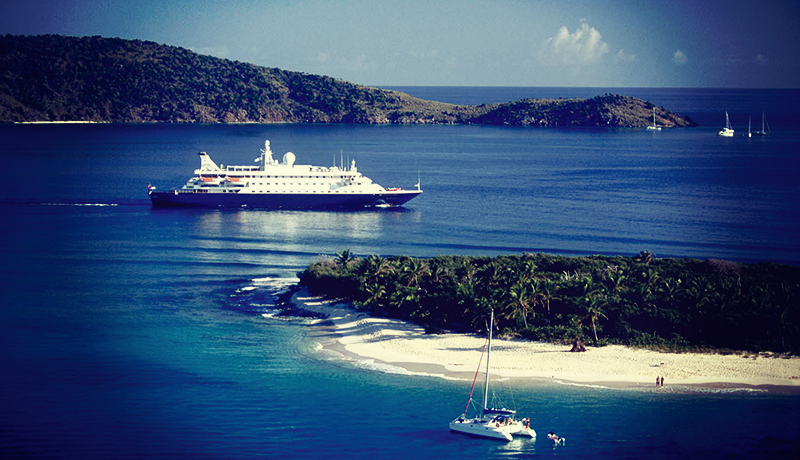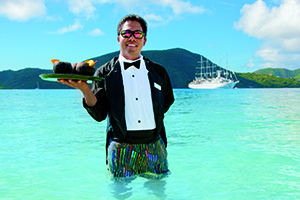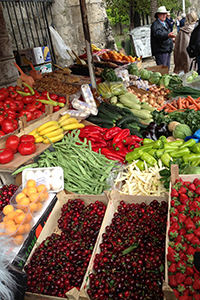

Where Sea Dreams Come True…
Photo Courtesy of SeaDream Yacht Club
Spend time on a major island and you’ll become quickly familiar with the mammoth cruise ships that frequent the port, herding color-coded groups of passengers to and from the shore. This scene, while a far cry from the luxurious getaway advertised, explains the low price tags often accompanying such packages. And though the chocolate fountain runneth over on these huge liners, so too do the overall disappointments about the impersonal on-sea experience.
As more travelers are realizing that all that glitters is not gold, smaller yachts are making waves in the industry. Companies such as SeaDream Yacht Club and Windstar Cruises advertise all the luxury of a larger ship (and then some) combined with a personalized experience and cultural immersion large cruise liners can’t even begin to match.
“The benefits of sailing small are abundant,” said Robert Lepisto, president of SeaDream Yacht Club, a company that takes boating enthusiasts through the Mediterranean, Caribbean and across the Atlantic. “SeaDream is able to offer guests a host of benefits that larger cruise lines cannot, including access to the most secluded destinations with ports so small that larger ships cannot enter.”
SeaDream’s crew of 95 serves a maximum of 112 guests, allowing each person to receive individualized and attentive service. And boasting one of the highest crew-to-guest ratios on the water makes for complete relaxation at sea. “The uncrowded destinations, the freshly prepared cuisine and the attentive service are all second to none,” Lepisto said.

Windstar’s Island Experience, Photo Courtesy of Windstar Cruises
Windstar’s six ships (three of which just launched in the past year and a half), which travel to Costa Rica, the Panama Canal, Tahiti and other tantalizing destinations, accommodate an average of 220 passengers, which is small enough for the crew to know most guests by name, the bartenders to remember your favorite drink and for the DJ to recall which song had you all over the dance floor the night before — even if you don’t.
Executive chef Rohit Dimri cooked for a major commercial cruise line for more than 12 years before joining Windstar in 2011. Now he leads a kitchen crew of 25 (including the galley), as opposed to the 376 he previously managed.
“I didn’t know half of them,” Dimri laughed. “Here, it’s very easy to know everybody’s caliber — what they can do, what they’re capable of. It’s easier to train them and mold them how you want them. It’s very hard with a big crew. It’s like going to a big school with big classes— maybe half the students are catching on. But when they go to a private institution, they learn more.”
Another major culinary advantage a small ship affords Dimri is the ability to buy fresh, local ingredients at each port. He’s sourced venison in Scandinavia, fresh seafood in Spain, cured meats in Italy, homemade cheese in Montenegro and fresh pressed olive oil in Greece.
“I have time to see local kitchens and learn from them,” said Dimri, who often asks local producers and small business owners for tips and suggestions. “You see the traditional way of what they’re making and it gets more interesting. It gives me more energy and then I come back with these things, try them in the kitchen and present to the guests. And then, when the guests like it, it gives me even more energy to do even better the next day!”
Windstar offers chef-led tours of local markets and intimate cooking classes, as well as hosts on-board barbecues and special dinners featuring the local products. None of this would be possible on a huge ocean liner.
“They are feeding 4,500 people; we are feeding 170 people, so it makes a big difference,” Dimri said. “It’s all about the fresh cooking that we are doing here. Your steak is cooked right away — fresh. When you’re on a big ship, there’s no other way to do it. When you have that many people, you have to cook 20 salmon at one time. Here, is one salmon at a time.”

Touring a Local Market, Photo Courtesy of Windstar Cruises
In addition to all the fresh ingredients sourced on each island, Dimri takes pride in using only top-quality products, such as Angus meat, and treating them with respect. All meats are carved to order, all breads and pastries are made in house, and nothing is frozen.
“If you do anything forcefully, it does not give out good results,” Dimri said. “That’s the key of cooking. Everything has to be done in the natural process. Keep it as natural as it is.”
If market tours and cooking classes aren’t your thing, Windstar affords many other opportunities to experience local culture through a variety of shore excursions led by area experts. Recent examples include a visit to a Danish painter’s studio, where guests learned about his work and then painted alongside him; a private tour of Estonia’s capital, Tallinn, led by one of the country’s diplomat; and a guided tour of the ancient city of Ephesus followed by a traditional Turkish meal in a small village.
“We want to make sure that the guest is experiencing the local culture, and doing it in a way that is real,” said Kelly Hubbard, Windstar’s director of product development. “Our excursions never go over 20 people. We do a ton of research and each region has a specific product manager whose sole reason is to create the shore excursions and private events for their area.”
To that end, all Windstar Cruises have begun featuring a free private event onshore to provide guests with an authentic cultural and culinary experience. Recent events included French dinner and dancers followed by a trip to the Grand Casino in Monaco and a beach barbecue with fire dancers in Tahiti featuring food made by locals.
“One of Windstar’s biggest opportunities is taking advantage of our smallness,” Hubbard said. “Guests will not experience the long lines, regimen and hassles that often come with larger ships. Our smallness also enables us to go where big ships can’t and bring our guests a longer and deeper immersion with our destinations.”
